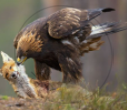Advertisements
Advertisements
प्रश्न
Name important defence mechanisms in plants against herbivory.
उत्तर
For plants, herbivores are the predators. Nearly 25 per cent of all insects are known to be phytophagous (feeding on plant sap and other parts of plants). The problem is severe for plants because, unlike animals, they cannot run away from their predators. Plants, therefore, have evolved an astonishing variety of morphological and chemical defences against herbivores. Thorns and spines (Acacia, cactus) are the most common morphological means of defence. Some plants release toxins that poison attacking herbivores, while others produce complex compounds that affect the attacker's growth cycle or ability to digest the plant. Plants have evolved several secondary metabolites used in plant defence, known as antiherbivory chemicals. These are nitrogen compounds (alkaloids, cyanogenic glycosides, benzoxazinoids), terpenoids, and phenolics. The weed Calotropis grows in abandoned fields. This plant produces highly poisonous cardiac glycosides. This is the reason why any cattle or goats are not commonly seen grazing on this plant.
APPEARS IN
संबंधित प्रश्न
Write what do phytophagous insects feed on.
State Gause’s Competitive Exclusion Principle.
Describe the mutual relationship between fig tree and wasp and comment on the phenomenon that operates in their relationship.
Select the statement which explains best parasitism.
Answer the following question.
Mention the term used to describe a population interaction between an orchid growing on a forest tree.
Association between sea anemone and Hermit crab in gastropod shell is that of.
Name the type of association: Crow feeding the hatchling of Koel
What is the ecological process behind the biological control method of managing pest insects?
Competition between species leads to ________.
Identify the interspecific interaction depicted in the following figure.

The interspecific interaction between Cuckoo and Crow is ______
Select the CORRECT match:
| I | II | ||
| i. | Competition | a. | Lichen |
| ii. | Commensalism | b. | Sea anemone and clownfish |
| iii. | Mutualism | c. | Lions and Leopards |
Identify the type of negative interaction.
Rafflesia an arnoldii is an example of ______.
What is brood parasitism? Explain with the help of an example.
Give one example for the following type.
Phytophagous animal
Pick out the appropriate association representing brood parasitism.
Carnivorous animals-lions and leopards, occupy the same niche but lions predate mostly larger animals and leopards take smaller ones. This mechanism of competition is referred to as ______.
A bird laying its egg in the nest of another bird is the type of ______.
What happens to an inferior competitor if a superior competitor is present in the same environment?
